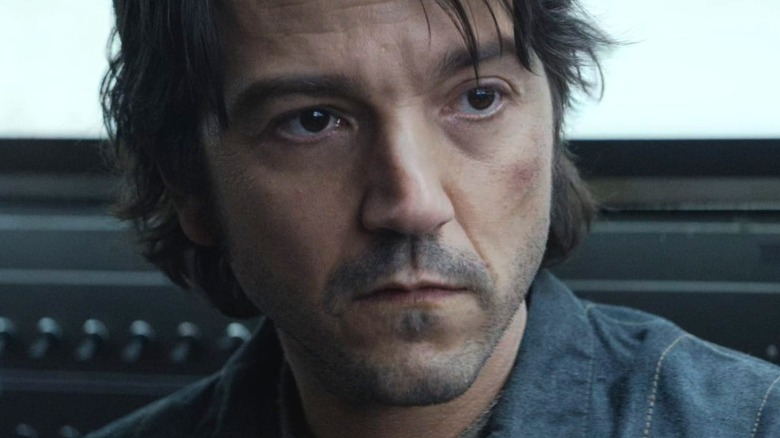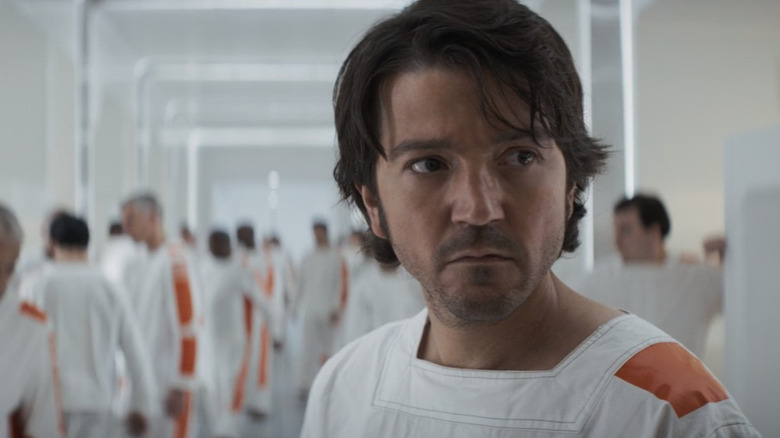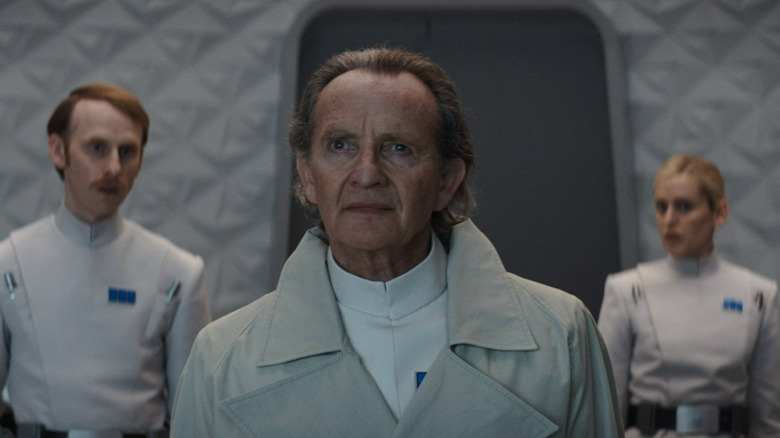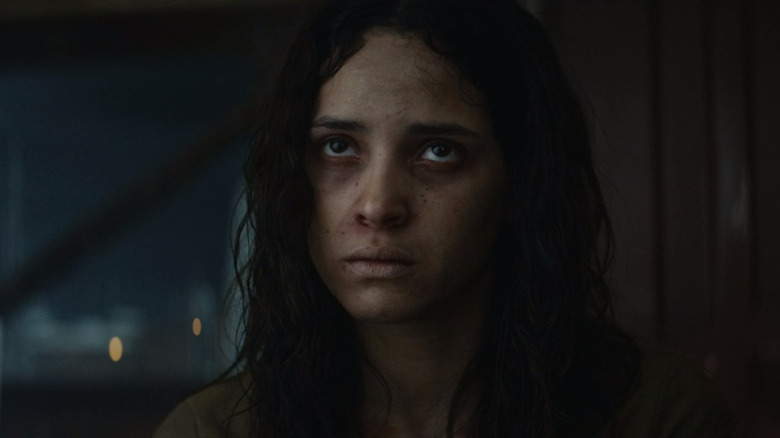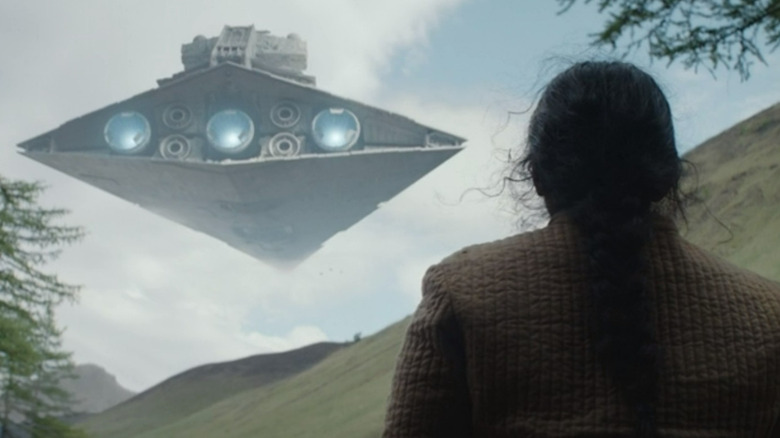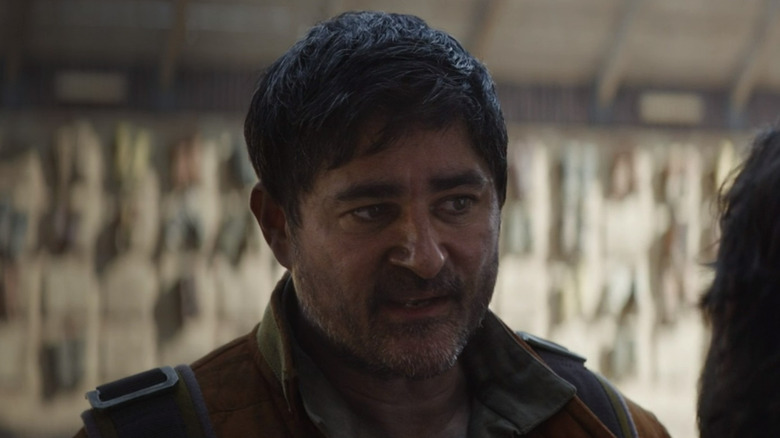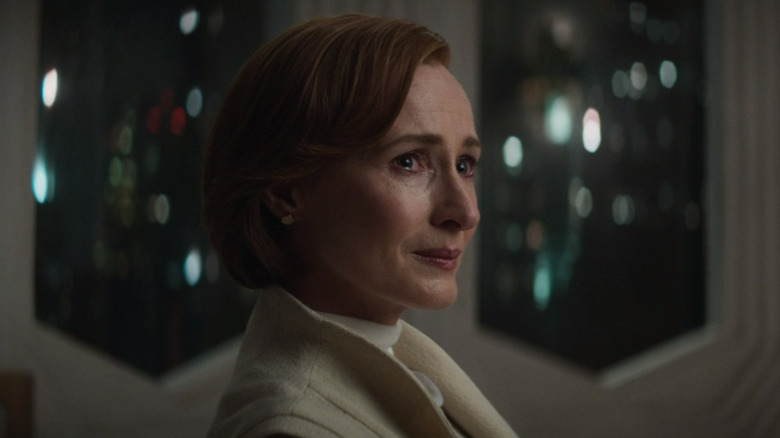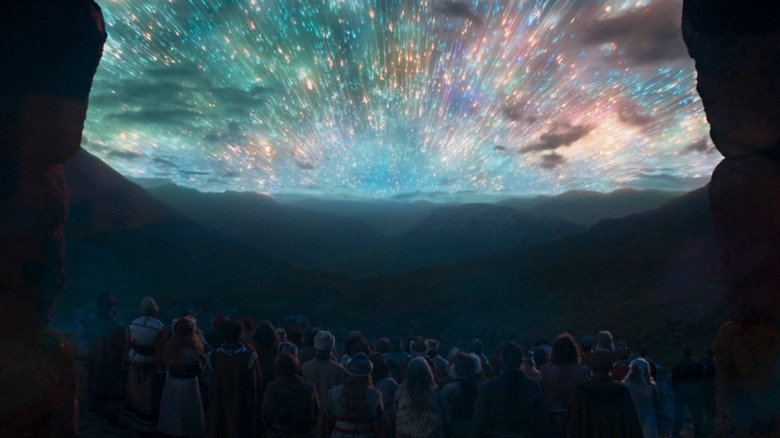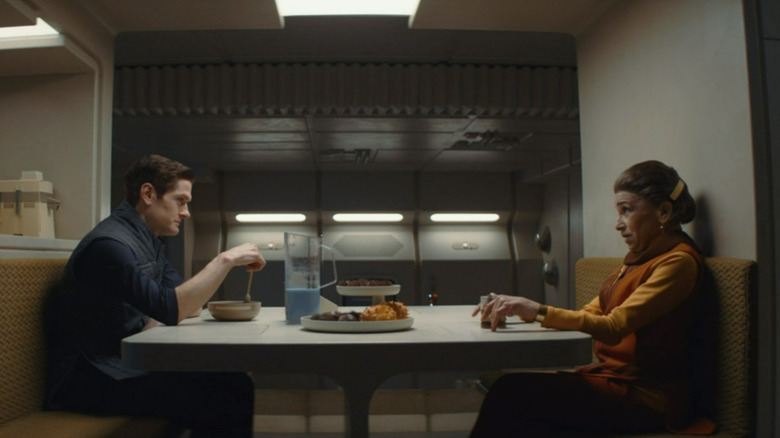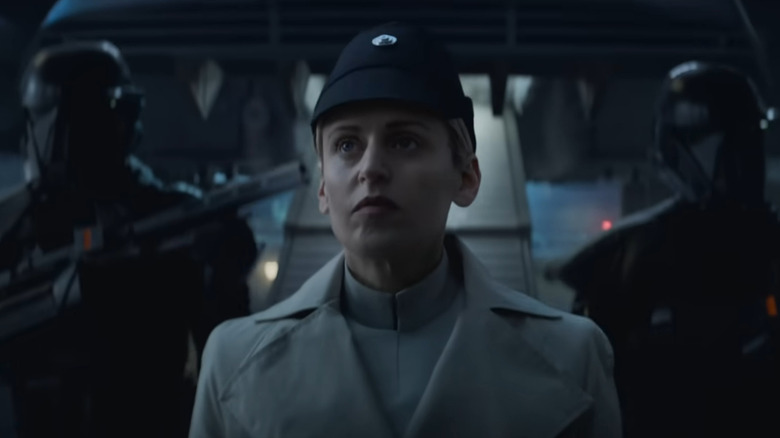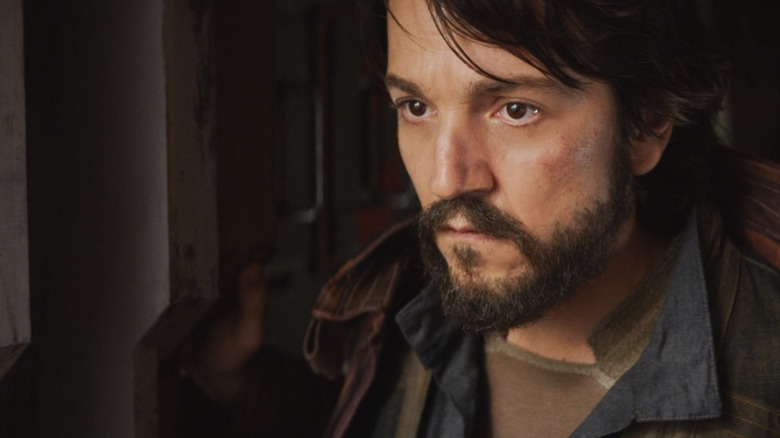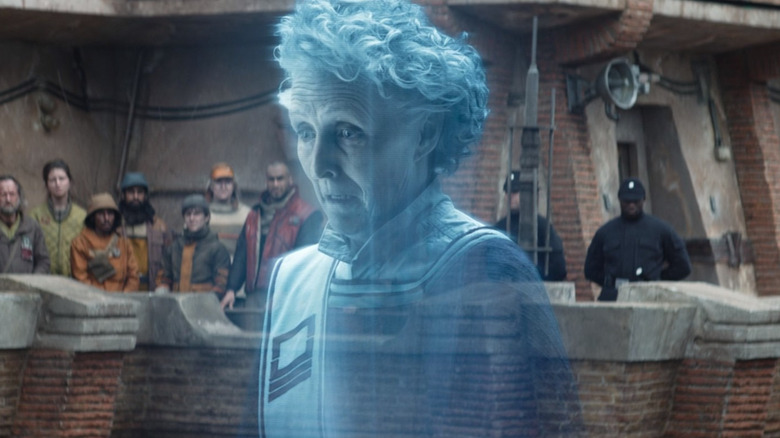Lessons Star Wars Should Learn From Andor
The stellar initial season of "The Mandalorian" foretold a bright future for "Star Wars" on Disney+ back in 2019. With a strong cast, grounded narrative, and tons of positive reviews, it made a strong case that the future of the franchise might lie on the small screen. Sadly, that promise yielded mixed results, with follow-ups like "The Book of Boba Fett" and "Obi-Wan Kenobi" failing to meet "The Mandalorian" Season 1's high standard. However, then a little show called "Andor" came out, and all was right with the world again.
Helmed by "Bourne" franchise writer Tony Gilroy and starring Diego Luna as his eponymous "Rogue One" character, the series begins roughly five years before the events of "Star Wars: A New Hope." While it is primarily an origin story for the titular rebel spy who meets his end in "Rogue One," "Andor" is so much more. With a massive cast of characters, the show plots the formation of the Rebel Alliance from numerous angles at once. We see the decline of the Imperial Senate, the erosion of personal rights under Palpatine's regime, and the fractious relations between different rebel cells. Through it all, "Andor" tells a powerful story about radicalization and the sacrifices necessary to fight oppression.
It's no secret that Disney's time as the gatekeeper of "Star Wars" has been pretty rocky so far. Despite the franchise's mass appeal, the company has failed to deliver consistent hits, but fortunately, they now have a strong blueprint for resurrecting it. Here are some lessons the rest of "Star Wars" should learn from "Andor" going forward.
Warning: There are spoilers ahead for "Andor" Season 1.
Every story doesn't need to be the same
Let's start with something obvious — "Andor" is not your typical "Star Wars" story. It's a show with brothels, corrupt cops, and emotionally abusive families. It's a show where the characters swear and the heroes shoot people in the back. Yet, at the same time, it never stops feeling like "Star Wars." While the show is paced more like a prestige drama from the likes of Netflix or HBO, it doesn't abandon the franchise in the interest of appearing dark and gritty. The tone serves the story, and the story is unmistakably "Star Wars."
This makes "Andor" living proof that you don't have to adhere to some strict code of conduct for a "Star Wars" story to work. Every movie and show doesn't need to be a jokey lightsaber fest that sells Happy Meal toys. Sure, merchandise will always be a driving force behind "Star Wars," but that doesn't mean that all its stories must be made with that in mind.
When "Star Wars: The Rise of Skywalker" was released, many fans criticized it for its corny, MCU-style quips and jokes. They fell flat because they felt formulaic rather than coming across as authentic to the story at hand. In "Andor," we see that a wide range of styles can work in the "Star Wars" universe. In a franchise that pumps out so much content every single year, shouldn't there be room for a bit of diversity in the storytelling? "Andor" proves that there is.
It's okay to slow things down
One of the main criticisms leveraged against "Andor" is that the show is paced too slowly and ends up being boring as a result. If you need blasters battles and lightsaber fights roughly every 30 minutes to keep from falling asleep, then it's true this may not be your show. However, as many have pointed out, it's the intentional pacing of "Andor" that makes it so compelling to watch.
To be clear, there is a time and place for more fast-paced, action-heavy "Star Wars" stories. It just happens that the place for that is pretty much the entire rest of the franchise. By slowing things down and zooming in, "Andor" brings a refreshing change of pace, largely thanks to its incredibly economical storytelling.
There's hardly a line out of place in all of Season 1. Every character interaction reveals subtle hints about what kind of people we're dealing with, while every shot helps to set the tone. By building up to each one of its action climaxes — which occur in Episodes 3, 6, 10, and 12 — Andor makes them all hit that much harder. We get to know Ferrix and Cassian's life there before he's forced to flee. We sit with the rebel group on Aldhani before they attempt their heist. In a franchise that's recently brought emperors back from the dead off-screen, it's refreshing to watch a show where every major beat is earned.
We don't need cameos to care about characters
There are only three major characters in "Andor" Season 1 who've been present in previous "Star Wars" media. The first is Cassian himself, who's the center of the action here. Then there's Mon Mothma, who barely had any development before "Andor," and finally Saw Gerrera, who's always been more of a fan favorite than a major player. That said, Bail Organa, Kanan Jarrus, Hera Syndulla, and Captain Rex are all characters who could have been force-fed into the "Andor" story but aren't — and the show is much better for it.
Under Disney, "Star Wars" has often become oddly like Wrestlemania. Every show is a chance for an unexpected challenger to rise from the shadows for a surprise chokeslam. Whether it's Darth Maul's infamous cameo at the end of "Solo: A Star Wars Story" or the truly baffling amount of Luke Skywalker we get in "The Book of Boba Fett," cameos have become so common in the series that they're usually more distracting than earned.
Rather than fall into that same trap, "Andor" fills its ranks with almost entirely new characters such as Luthen, Cinta, Kino, Brasso, Syril, Dedra, Maarva, B2EMO, and so many others. "Andor" shows that when you write interesting new characters who make sense in your story, they can be just as compelling as characters we've known for decades. Even Saw Gerrera serves the story first and the fan service second, as all good cameos should.
The Jedi are only one part of the story
You don't need a PhD in kyber physics to understand why the Jedi are so prevalent in "Star Wars." Apart from being absolutely central to the big-picture story, they're just cool. They're space wizards with cool robes and laser swords — what's not to like? Apart from the constant corruption and self-righteousness, that is.
Still, no matter how fun and compelling the Jedi may be, they don't need to be in every "Star Wars" story. A big reason why George Lucas' original film took off was that it felt grounded while also being fantastical. Han Solo, the Millennium Falcon, the Mos Eisley Cantina — none of these iconic inclusions have anything to do with the Jedi or the Force. However, as the "Star Wars" saga has been rebranded as "The Skywalker Saga," Jedi storylines have become even more ubiquitous. Shows like "Star Wars Rebels" and "Tales of the Jedi," games like "Jedi: Fallen Order," and even "The Mandalorian" have at least at times served as vessels for more Jedi adventures, sometimes at the detriment of everything else.
"Andor" feels different, affecting, and real because it eschews the instinct to fall back on the Jedi. Every arc shows us interesting new corners of the galaxy that have nothing to do with the wielders of the Force, and it feels like a breath of fresh air. If Disney had adopted this approach earlier on, maybe Finn and Poe would not have been so readily discarded later in the sequel trilogy.
Special effects can't solve everything
Unlike every live-action "Star Wars" series that came before it, "Andor" didn't shoot in the Volume — the massive, wrap-around digital stage setup that Disney has started using in many of its effects-heavy projects. The Volume has yielded some impressive results in shows like "The Mandalorian," but we've also started seeing its limits more recently. "Obi-Wan Kenobi," for instance, received some criticism for its own reliance on the Volume's digital backdrops, particularly for resulting inconsistencies in the show's lighting.
"Andor" Season 1 has no such issues because it was filmed entirely on location. As a result, dense environments like the sprawling scrapyards of Ferrix and the rolling hills of Aldhani feel far more real and immersive. The responsibility falls wholly to the many designers, set dressers, and costumers to make the world feel alive — and they nail it.
The Volume is an impressive technology that has been used to stunning effect in the past. It won't stop being a piece of "Star Wars" production anytime soon, nor should it. However, "Andor" shows just how much can be gained by returning to more traditional production methods. Not every "Star Wars" story needs to be shot in the same high-def bubble.
CGI is no match for real actors
There's a crime far greater than turning to the dark side in "Star Wars," and its recasting old roles. At least, that seems to be how Disney feels about the situation. Since acquiring Lucasfilm, the company has filled its "Star Wars" movies and shows with CGI Muppet people pulled straight from the uncanny valley with efforts to recreate characters like Princess Leia, Grand Moff Tarkin, and Luke Skywalker. While the technology involved in these effects is obviously impressive (if occasionally a little disturbing), the results have generally been more distracting than exciting. Yes, seeing Luke mow down Dark Troopers in "The Mandalorian" Season 2 is fun, but as soon as he lifts the hood, the spell is broken.
"Andor" lives on the other end of the performance spectrum, with no such computer-grafted characters. There aren't even many alien characters in Season 1 of the show, which isn't necessarily a good thing, but it does keep the focus tight. This a show led by actors — not VFX artists, deep fakes, or rubber suits. While not every "Star Wars" project needs to follow that same model, "Andor" is a strong reminder of what can happen when you let the actors lead the way.
Fiona Shaw, Stellan Skarsgård, Forest Whitaker, Genevieve O'Reilly, Andy Serkis, and many more deliver powerful, personal moments in "Andor" Season 1. Disney needs to remember that if they want us to care about characters, the uncanny valley stuff needs to go.
Start exploring the galaxy again
Another habit that recent "Star Wars" stories have frequently followed is the instinct to return to familiar locations. Tatooine, in particular, has been featured so prominently in "The Mandalorian," "Obi-Wan Kenobi," and "The Book of Boba Fett" that the once beloved planet has become almost entirely dull. While these shows have also introduced plenty of new worlds — like Nevarro, Corvus, and Daiyu — most of them are more stepping stones than places that make a lasting impression.
There's a reason that Hoth, Dagobah, Coruscant, Tatooine, and other classic "Star Wars" planets have remained so popular. They feel unique, fantastical, and real at the same time, with lots of little details to grab onto. "Star Wars" is as much about exploring the galaxy as it is about the conflicts within it, and "Andor" embraces that idea to great effect.
Ferrix and Aldhani, in particular, are fantastic additions to the "Star Wars" universe, as each brings something new and compelling that we haven't seen before. The dense townscape and winding footpaths of Ferrix give it a ton of personality, as do the cultural touches like the bell tower and the wall of work gloves. The show efficiently shows us what kind of place it is, which makes us want to stay there and explore. Aldhani accomplishes this in another way by showing us the Eye, a magnificent natural phenomenon central to the local religion. Exploring the galaxy isn't just about cool sets — it's also about showing us the fantastical.
Villains need to be real
George Lucas has never let us forget that "Star Wars" was made for children – and there's nothing wrong with that. Inevitably, when you're writing stories with children in mind, the bad guys can only be so threatening. Otherwise, things get dark real fast. That's particularly true in animated series like "Star Wars Rebels" and "Star Wars Resistance," which is to be expected when working with cartoons. However, because these shows are so clearly for younger viewers, it all works out.
The problem is when your villains stop to real characters entirely and start being too abstract and cartoonish. The "Star Wars" sequel trilogy is especially guilty of this, featuring complex villains like Andy Serkis inside a giant Muppet and the hollow corpse of Sheev Palpatine. When the villains in your story cease to feel real, the stakes no longer hold up. Suddenly, the whole story starts to falter, all because the bad guys are more bad than guys.
In "Andor," every evil overlord and sniveling grunt is painted with vivid, human colors. Syril Karn (Kyle Soller) is detestable, but we are given a chance to understand why he is the way he is. We see his sad childhood bedroom. We hear the abuse in his mother's nagging voice. Dedra Meero (Denise Gough) is similarly complex — a woman who wants desperately to be recognized by her superiors, but also believes that their methods are antiquated. By making the villains as intriguing as the heroes, "Andor" creates a much richer world to explore.
The less fan service you give, the harder it hits
"Andor" doesn't just lack lightsabers and Force powers. For most of Season 1, it lacks fan service in general. We don't see a TIE fighter until Episode 4, and we don't see a stormtrooper until halfway through the season. Even space chases and blaster battles are rare, only popping up in the show's handful of climaxes. However, when "Andor" does dip into the old fan service well, it pulls out gold every time.
From the TIE fighter chase sequence in "The Eye" to Luthen's escape from an Imperial cruiser in "Daughter of Ferrix" to the Death Trooper showdown in the Season 1 finale, "Andor" picks its moments carefully. It doesn't overload you with familiar helmets and spaceships, but when it does use them, they make a big impact.
Aside from fan service, this more reserved approach also has positive repercussions on the larger world of the show. For decades, stormtroopers have been a joke, reduced to the subject of a never-ending series of memes about how they can't aim. "Andor" makes them actually intimidating, as they only show up at the most high-stakes moments. When they arrive, viewers know they mean business. If the rest of the "Star Wars" universe were just a little more conservative in its fan service, the whole franchise would be better for it.
Let the characters lead the way
From the start, "Star Wars" has been a mythic story. Its world is one where magic, prophecies, and betrayals are the norm, where heroes enter exile and no one ever truly dies. Many of the franchise's greatest moments have been borne of that mythic quality, but it has occasionally hurt the story — especially under Disney.
In "Star Wars: The Force Awakens," Finn (John Boyega), Poe (Oscar Isaac), and Rey (Daisy Ridley) are all treated as relative equals in the story. By the end of the sequel trilogy, the story centers almost exclusively on Rey and Kylo Ren (Adam Driver). Boyega himself has even spoken out since "The Rise of Skywalker" about how diminished Finn became. By the end of the trilogy, a lot of things fall flat because only half the main cast has any real role in the main story. "Andor," as you might expect, doesn't have that problem.
To be fair, it's much easier to make more ordinary characters matter when Jedi and Sith aren't involved. Still, even in the genre of myth, you can't abandon your characters in their own story. Every chapter of "Andor" is driven by its characters — by their fears, desires, and convictions. As a result, every event has real power because we know the personal stakes. We see the choices that lead to the big moments. At the end of the day, the story has to serve the characters, not the other way around. When those two get mixed up, it looks a lot like "Somehow, Palpatine returned."
Don't shy away from being topical
Showrunner Tony Gilroy has said that "Andor" was meant more as a reflection on revolutionary history than the modern political moment (per IndieWire). While that may be true, it's hard not to see a lot of the real world in the show. Palpatine's Empire is a fascist regime, and "Andor" treats it accordingly, from police profiling and racial discrimination to the exploitation of prison labor. This approach doesn't sacrifice the in-universe story. Rather, it enriches it by treating it with respect.
"Andor" is a far cry from the first "Star Wars," where Princess Leia watches her entire planet destroyed in one scene and tosses out quippy zingers in the next. There's nothing wrong at face value with a more lighthearted adventure story, but it's interesting to see "Andor" treat the Empire with real gravity. It's no coincidence that Ferrix looks so much like Northern Ireland or that the Aldhani scenes were shot in the Scottish highlands. As Jonathan Holmes of Wired wrote in 2018, Lucas' Empire has always spoken with "the voice of Imperial Britain," and "Andor" takes that metaphor quite seriously.
The show still takes place in a galaxy far, far away, but it feels a lot more like our own much of the time. Perhaps the greatest trick that "Andor" pulls off is grounding itself in real history without sacrificing the escape of adventure.
